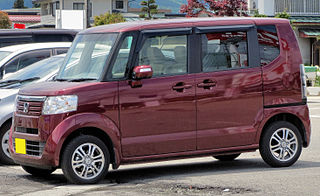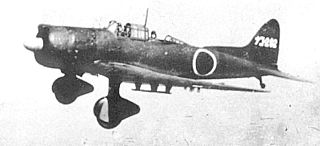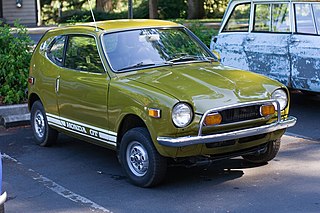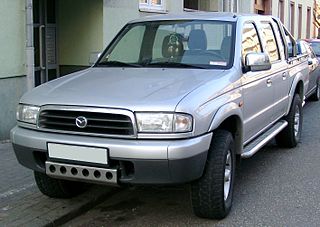
Kei car is the smallest category of Japanese expressway-legal motor vehicles. The term kei is a shortening of kei-jidōsha,, which translates to English as “light vehicle”.

Aichi Kokuki KK was a Japanese aerospace manufacturer which produced several designs for the Imperial Japanese Navy. After the war, the company was reorganized as Aichi Machine Industry Co., Ltd (愛知機械工業) where they made small kei cars until 1966 when they were integrated into Nissan and developed the Nissan Sunny and Nissan Vanette.

The Nissan Vanette is a cabover van and pickup truck produced by the Japanese automaker Nissan from 1978 until 2011. The first two generations were engineered by Nissan's Aichi Manufacturing Division for private, personal ownership, with the last two generations built by Mazda, rebadged as Nissans and refocused as commercial vehicles, based on the Mazda Bongo. The van has also been sold as the Nissan Sunny-Vanette or Nissan Van. The private purchase passenger platform was replaced by the Nissan Serena in 1991, renamed Vanette in various international markets, and came equipped with multiple engine and drivetrain configurations.

The Mitsubishi Minica is a model series of kei cars, produced by Mitsubishi Motors Corp. (MMC) over five generations, from 1962 to 2011, mainly for the Japanese domestic market.

The Nissan A series of internal combustion gasoline engines have been used in Datsun, Nissan and Premier brand vehicles. Displacements of this four-stroke engine family ranged from 1.0-liter to 1.5-liter and have been produced from 1967 till 2009. It is a small-displacement four-cylinder straight engine. It uses a lightweight cast iron block and an aluminum cylinder head, with overhead valves actuated by pushrods.

The Honda Z is a two-door hatchback kei car/city car manufactured and marketed by the Honda Motor Company, from 1970 until 1974. Exports mostly ended after 1972, when the domestic market models received redesigned pillarless bodywork.

The Mazda B series is a series of pickup trucks that was manufactured by Mazda. Produced across five generations from 1961 to 2006, the model line began life primarily as a commercial vehicle, slotted above a kei truck in size. Through its production, Mazda used engine displacement to determine model designations; a B1500 was fitted with a 1.5 L engine and a B2600, a 2.6 L engine.

The Datsun truck is a compact pickup truck made by Nissan in Japan from 1955 through 1997. It was originally sold under the Datsun brand, but this was switched to Nissan in 1983. It was replaced in 1997 by the Frontier and Navara. In Japan, it was sold only in Nissan Bluebird Store locations.

The Suzuki Fronte is an automobile introduced in March 1962 as a sedan version of the Suzulight Van. The nameplate remained in use for Suzuki's Kei car sedans as well as some commercial-use derivatives until it was replaced by the Alto in September 1988.

The Daihatsu Hijet is a cab over microvan and kei truck produced and sold by the Japanese automaker Daihatsu since 1960. Despite the similarities between the Hijet name and Toyota's naming scheme for its trucks and vans, the name "Hijet" has been in use for Daihatsu's kei trucks and microvans since 1960, over two decades before Toyota took control. "Hijet", when transliterated into Japanese, is very similar to "Midget", one of Daihatsu's other mini-trucks. According to Daihatsu, the name "Hijet" was created to imply that the vehicle offers higher performance than the Midget. The Hijet competes in Japan with the Honda Acty, Mitsubishi Minicab, Nissan Clipper, Subaru Sambar and Suzuki Carry.

The Honda Acty is a series of cabover microvans and kei trucks produced by the Japanese automaker Honda from 1977 to 2021, designed for the Japanese domestic market (JDM). "Acty" is short for "Activity".

The Honda Life is an automobile nameplate that was used on various kei car/city cars produced by Honda: passenger cars, microvans, and kei trucks. The first series of the nameplate was built between 1971 and 1974, with the nameplate revived in 1997 and used until 2014. The Japanese-market Life has rarely been marketed outside Japan.

The Honda N360 is a small front-engine, front-wheel drive, two-door, four-passenger car manufactured and marketed by Honda from March 1967 through 1970 in Japan's highly regulated kei class — as both a two-door sedan and three-door wagon.
The Honda Vamos is a leisure vehicle originally produced by Japanese automaker Honda from 1970 to 1973, and reintroduced again as a trim level of the Honda Acty microvan starting in 1999. Its name, "Vamos", is Spanish and Portuguese for "let's go".

The Subaru Sambar is a cabover truck and microvan manufactured and marketed by Subaru as Japan's second truck compliant with the country's strict Keitora (軽トラ) or Kei vehicle tax class, after the Kurogane Baby. Introduced in 1961 in microvan and Kei pickup configurations, the Sambar remains in production, now in its eighth generation — beginning with the sixth generation as a rebadged Daihatsu Hijet.

The Mitsubishi Minicab is a kei truck and microvan, built and sold in Japan by Japanese automaker Mitsubishi Motors since 1966. In Japan, it was sold at a specific retail chain called Galant Shop. It was also sold by China Motor Corporation (CMC) in Taiwan as the CMC Veryca, starting in 1985. A battery electric model of the Minicab, called the Minicab MiEV, is sold in the Japanese market since December 2011.

A kei truck, kei-class truck, or Japanese mini truck, known in Japan as a keitora, is a style of pickup truck built to satisfy the Japanese keijidōsha statutory class of light vehicles. Limited to certain size restrictions—currently no more than 3.4 m (11.2 ft) long and 1.48 m (4.9 ft) wide—they are produced by a wide range of Japanese automakers and are available in rear-wheel or four-wheel drive.

The TN360 and its successors in the long running TN series is a cab over pickup truck from Honda, which replaced the T360 in November 1967.

The Suzuki FB engine is a series of two- and three-cylinder two-stroke engines that was produced by the Suzuki Motor Corporation from October 1961 until November 1987. They were used in a number of Kei-class automobiles and light trucks. From the original air-cooled 359 cc (21.9 cu in) straight-twin version the FB series developed through a number of different models having different names, ending with the water-cooled, three-cylinder LJ50. The names used for various versions of this engine often refer to the chassis code of the cars in which they were introduced, until Suzuki changed their engine naming system sometime in the first half of the 1970s.

The Honda N-Van is a microvan produced by Honda for the Japanese market. The origin for the vehicle's name expresses "next generation light van" proposed by N series as see in the N-One, N-Box, and N-WGN: it is part of a renewed line-up of Kei class city cars. The use of the letter "N" in the name was used by Honda for the late 1960s and 1970s Honda N360.



















